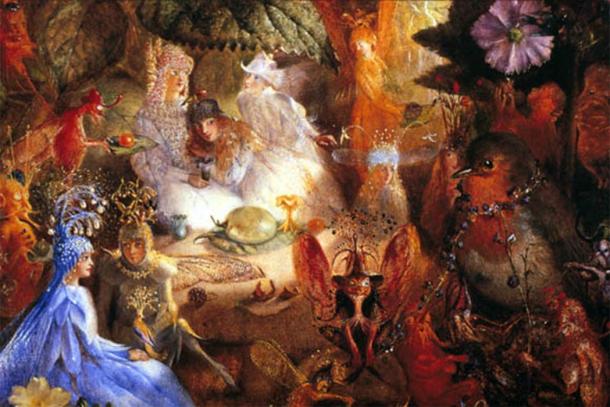Faerie-type entities have always been an important component of British and Irish folklore. In the Aarne-Thompson-Uther Motif Index of Folk Literature (ATU) there are over 500 motifs within folktales that include the faeries, many of which are from Britain and Ireland. Whatever the true ontology of these supernatural entities, it is evident they have had an intrinsic cultural role throughout recorded history and played a part in the storytelling of every generation since the Middle Ages, and perhaps even earlier. The folklore collected by Medieval chroniclers was almost certainly the culmination of centuries of oral tradition, and by the time it was recorded in earnest from the 19th century, it represented belief systems stretching back at least a thousand years.

The captive robin by John Anster Fitzgerald (1864) ( Public Domain )
Despite the continuation through history of the oral tradition, one is reliant, primarily, on the written record for an understanding of the faeries’ cultural representation. And the faeries can be found in a range of sources as a consistent folkloric taxonomy; their roles and appearance may change through time, but they are always recognizable in their phenomenology. Whoever is collecting the folklore – and this can sometimes be an accidental collection – there is a concession and awareness of what they represent. Although framing their research in different ways, the folklorists of the 19th-21st centuries would recognize the faeries of Medieval chroniclers or Early-Modern commentators as being of the same category of beings they were investigating. It is in Britain and Ireland that some of the first folkloric testimonies of the faeries found their way into the written record.

Merlin presenting the future king Arthur by Emil Johann Lauffer (pre 1909) (Public Domain )
Chronicling Medieval Faeries
During the Medieval period the faeries were incorporated into what later became called ‘The Matter of Britain ’, an Arthurian mythos, which was consumed by the small proportion of literate population and were codified accordingly to suit their social expectations. The appearance of characters with supernatural qualities within these stories had, therefore, to adhere to certain doctrines, which would be acceptable to their social mores and belief systems. Subsequently, the cast of characters specifically ascribed faerie qualities in the Arthurian mythos were invariably given the attributes of nobility. Much Medieval and later folklore includes facets of a royal hierarchical organization within the metaphysical faerie realm, but in the Arthurian cycle of stories the quality of ‘faerie’ is subsumed into an unique set of players whose nobility ensured their respect and credence among the aristocratic audiences listening to or reading the stories.
Like this Preview and want to read on? You can! JOIN US THERE ( with easy, instant access ) and see what you’re missing!! All Premium articles are available in full, with immediate access.
For the price of a cup of coffee, you get this and all the other great benefits at Ancient Origins Premium. And – each time you support AO Premium, you support independent thought and writing.
Neil Rushton is an archaeologist and freelance writer who has published on a wide variety of topics from castle fortifications to folklore. His latest book is Dead but Dreaming
Top Image: The artists dream by John Anster Fitzgerald (1860) ( Public Domain )
By Neil Rushton
Related posts:
Views: 0
 RSS Feed
RSS Feed

















 September 1st, 2020
September 1st, 2020  Awake Goy
Awake Goy  Posted in
Posted in  Tags:
Tags: 
















